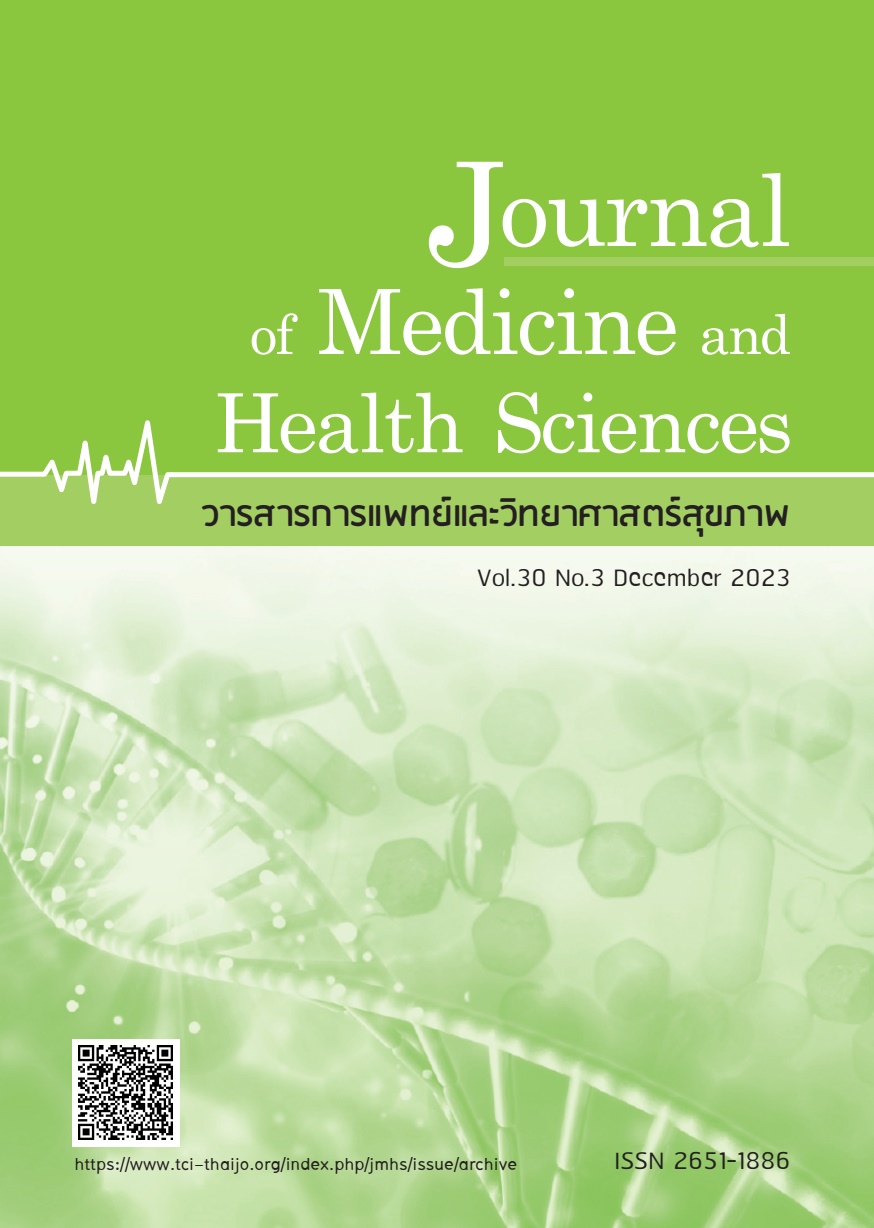Comparing the first-pass success rate of oral intubation in patients who received or did not receive add-on topical lidocaine in the upper airway: A pilot randomized controlled trial
Keywords:
topical lidocaine, emergency department, first-pass success rate, endotracheal intubationAbstract
The intubation with sedatives method is commonly employed by general practitioners in the emergency department (ED) in Thailand. This pilot study aimed to assess the feasibility of conducting a larger definitive trial on the first-pass success rate of oral intubation in patients who received or did not receive add-on topical lidocaine in the upper airway. This parallel two-arm pilot randomized controlled trial took place in the emergency department of Somdejphrajoataksinmaharaj Hospital, spanning from October 2022 to April 2023. Participants included patients aged 18 years and older with an indication for oral intubation with a laryngoscope, screened using eligibility criteria for enrollment. Patients were randomized and assigned to either of the two study arms through sealed envelopes. The control arm received oral intubation with or without sedation, while the intervention arm received topical lidocaine applied to the upper airway in addition to the therapy in the control arm. Feasibility was assessed based on the recruitment rate, adherence to group assignment, and data completeness. The primary outcome was the first-pass success rate, while secondary outcomes were peri-intubation complications. During this period, 259 patients were intubated in the ED, but 179 patients were excluded. A total of 80 patients were randomly assigned to each group, with 40 patients in the intervention arm and 40 patients in the control arm. The study achieved its recruitment rate goal within 6 months, and adherence to the protocol was 97.5%. However, data completeness fell below expectations at 91.3% compared to the target of 95.0%. The first-pass success rate was 72.5% in the intervention group and 60.0% in the control group (Difference 12.5%; 95% CI, 8.0-33.0). Peri-intubation desaturation below 90% was more prevalent in the intervention group, with 22.5% versus 10.0% in the control group (Difference 12.5%; 95% CI, 3.4-28.4). Some patients with oxygen saturation below 90% at the end of preoxygenation were enrolled. Physicians performing intubation found it challenging to administer lidocaine in a supine position to agitated and uncooperative patients. Conducting a larger sample size in the future study, which could reveal statistical differences in clinical outcomes, is feasible by modifying exclusion criteria, improving the data collection process, and refining the method of topical lidocaine administration.
References
Calvin A. B, Ron M. Wall. Airway In: Rosen’s emergency medicine: Concepts and clinical practice. 9th ed. Philadelphia: Elsevier; 2018. p. 3-24.
Sujinpram C. First-pass intubation successful with rapid sequence intubation versus conventional endotracheal intubation in emergency department. MJSBH 2020 Dec 30;35:729-38. [in Thai]
Saoraya J, Vongkulbhisal K, Kijpaisalratana N, et al. Difficult airway predictors were associated with decreased use of neuromuscular blocking agents in emergency airway management: a retrospective cohort study in Thailand. BMC Emerg Med 2021;25;21:37.
Chanthawong S, Chau-In W, Plailaharn N, et al. A prospective study of tracheal intubation and immediate complications in emergency room in Srinagarind hospital. Srinagarind Med J 2015;5;30:256-61. [in Thai]
Kim C, Kang HG, Lim TH, et al. What factors affect the success rate of the first attempt at endotracheal intubation in emergency departments? Emerg Med J 2013;30:888-92.
Walls RM, Brown CA, Bair AE, et al. NEAR II Investigators. Emergency airway management: A multi-center report of 8937 emergency department intubations. J Emerg Med 2011;41:347-54.
Srivilaithon W. Prospective observational study of emergency airway management in emergency department. J Med Assoc Thai 2016;99:S131-7.
Sakles JC, Chiu S, Mosier J, et al. The importance of first-pass success when performing orotracheal intubation in the emergency department. Acad Emerg Med 2013;20:71-8.
Pani N, Kumar Rath S. Regional & topical anaesthesia of upper airways. Indian J Anaesth 2009;53:641-8.
Ahmad I, El-Boghdadly K, Bhagrath R, et al. Difficult airway society guidelines for awake tracheal intubation (ATI) in adults. Anaesthesia 2020;75:509-28.
Cocks K, Torgerson DJ. Sample size calculations for pilot randomized trials: a confidence interval approach. J Clin Epidemiol 2013;66:197-201.
Reed MJ, Dunn MJG, McKeown DW. Can an airway assessment score predict difficulty at intubation in the emergency department? Emerg Med J 2005;22:99-102.
April MD, Arana A, Reynolds JC, et al. Peri-intubation cardiac arrest in the emergency department: A national emergency airway registry (NEAR) study. Resuscitation 2021;1;162:403-11.
Catterall WA, Mackie K. Local Anesthetics. In: Brunton LL, Chabner BA, Knollmann BC, editors. Goodman & Gilman’s: The pharmacological basis of therapeutics [Internet]. 12th ed. New York, NY: McGrawHill Education; 2015 [cited 2023 Apr 22]. Available from: accessmedicine. mhmedical.com/content.aspx?aid=1127866670.
Chung DC, Mainland PA, Kong AS. Anesthesia of the airway by aspiration of lidocaine. Can J Anesth 1999;1;46:215-9.
Downloads
Published
How to Cite
Issue
Section
License

This work is licensed under a Creative Commons Attribution-NonCommercial-NoDerivatives 4.0 International License.



